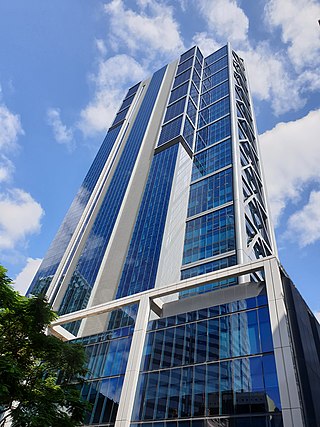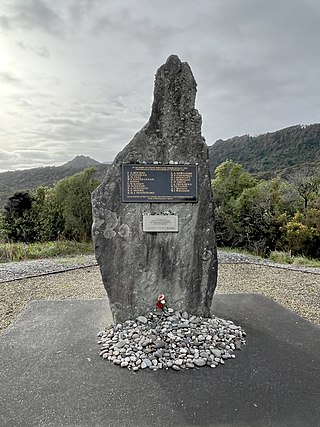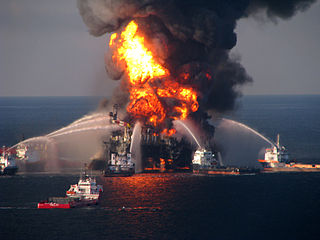
BHP Group Limited is an Australian multinational mining and metals public company headquartered in Melbourne, Australia.
A mining accident is an accident that occurs during the process of mining minerals or metals. Thousands of miners die from mining accidents each year, especially from underground coal mining, although accidents also occur in hard rock mining. Coal mining is considered much more hazardous than hard rock mining due to flat-lying rock strata, generally incompetent rock, the presence of methane gas, and coal dust. Most of the deaths these days occur in developing countries, and rural parts of developed countries where safety measures are not practiced as fully. A mining disaster is an incident where there are five or more fatalities.

Teck Resources Limited, known as Teck Cominco until late 2008, is a diversified natural resources company headquartered in Vancouver, British Columbia, that is engaged in mining and mineral development, including coal for the steelmaking industry, copper, zinc, and energy. Secondary products include lead, silver, gold, molybdenum, germanium, indium and cadmium. Teck Resources was formed from the amalgamation of Teck and Cominco in 2001.

Xstrata plc was an Anglo-Swiss multinational mining company headquartered in Zug, Switzerland and with its registered office in London, United Kingdom. It was a major producer of coal, copper, nickel, primary vanadium and zinc and the world's largest producer of ferrochrome. It had operations in 19 countries across Africa, Asia, Australasia, Europe, North America and South America.

Massey Energy Company was a coal extractor in the United States with substantial operations in West Virginia, Kentucky and Virginia. By revenue, it was the fourth largest producer of coal in the United States and the largest coal producer in Central Appalachia. By coal production weight, it was the sixth largest producer of coal in the United States.
Solid Energy was the largest coal mining company in New Zealand and is a state owned enterprise of the New Zealand Government.
The Pike River Mine is a coal mine formerly operated by Pike River Coal 46 km (29 mi) north-northeast of Greymouth in the West Coast Region of New Zealand's South Island. It is the site of the Pike River Mine disaster that occurred on 19 November 2010, leading to the deaths of 29 men whose remains have not been recovered. The mine and its assets are owned by the Department of Conservation, whom, on 1 July 2022, assumed ownership and management following the dissolution of the Pike River Recovery Agency. The former mine site and its surrounding land are a part of Paparoa National Park.

The Brunner Mine disaster happened at 9:30 am on Thursday 26 March 1896, when an explosion deep in the Brunner Mine, in the West Coast region of New Zealand, killed all 65 miners below ground. The Brunner Mine disaster is the deadliest mining disaster in New Zealand's history.

Mining in New Zealand began when the Māori quarried rock such as argillite in times prior to European colonisation. Mining by Europeans began in the latter half of the 19th century.

The Brunner Mine was a coal mine on the West Coast of the South Island in New Zealand.

The Strongman Mine was an underground coal mine north of Greymouth on the West Coast of New Zealand from 1938 to 2003.
The Pike River Mine disaster was a coal mining accident that began on 19 November 2010 in the Pike River Mine, 46 km (29 mi) northeast of Greymouth, in the West Coast region of New Zealand's South Island following a methane explosion at approximately 3:44 pm. The accident resulted in the deaths of 29 miners.
The Górniczy Agregat Gaśniczy (GAG) is a jet engine inertisation unit developed for use in mines, controlling and suppressing coal seam fires and neutralising firedamp situations. The unit was designed in Poland in the 1970s, its name roughly translates as "Mine Fire Suppression Apparatus". A GAG 3A unit was developed by the Queensland Mines Rescue Service, in association with the Commonwealth Scientific and Industrial Research Organisation (CSIRO). GAG units have been used in Australia since 1998.
Alpha Metallurgical Resources is a large American producer of metallurgical coal for the industrial production of steel and iron and low-sulfur thermal coal to fuel steam boilers for the production of electrical power. In November, 2018 the company was acquired by Contura Energy. The company also provides industry services relating to equipment repairs, road construction and logistics, with domestic operations and coal reserves within the states of Virginia, West Virginia, Kentucky, Wyoming, Utah, Illinois, Tennessee, and Pennsylvania. Alpha Natural Resources does not produce all of the coal it sells; much of the coal sold by Alpha Natural Resources is purchased from independent mining operations and then resold in the worldwide market.

Energy resources bring with them great social and economic promise, providing financial growth for communities and energy services for local economies. However, the infrastructure which delivers energy services can break down in an energy accident, sometimes causing considerable damage. Energy fatalities can occur, and with many systems deaths will happen often, even when the systems are working as intended.
The Pike River Recovery Agency was a stand-alone New Zealand Government department. Established in 2018, its stated aim was to work with families of victims of the 2010 Pike River Mine disaster to plan and facilitate the manned re-entry of the mine's drift. The Agency's purpose was to gather evidence on the disaster with the goals of preventing future mining accidents, giving the Pike River families closure and, if possible, recovering the bodies of the deceased miners.
New Zealand mine disaster may refer to:

New Zealand coal reserves are in excess of 15 billion tonnes, mainly in Waikato, Taranaki, West Coast, Otago and Southland. Over 80% of the reserves are in Southland lignite deposits. These were worth $100 billion in 2010.










